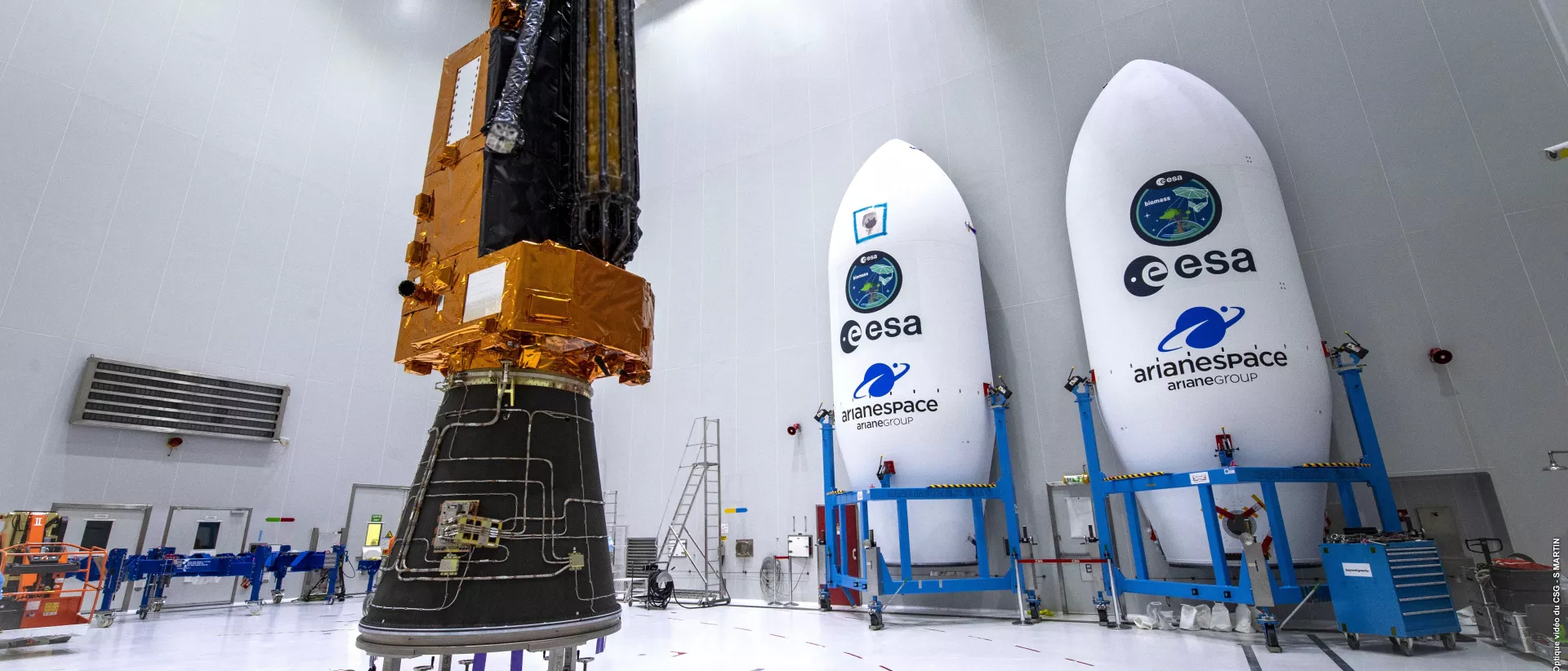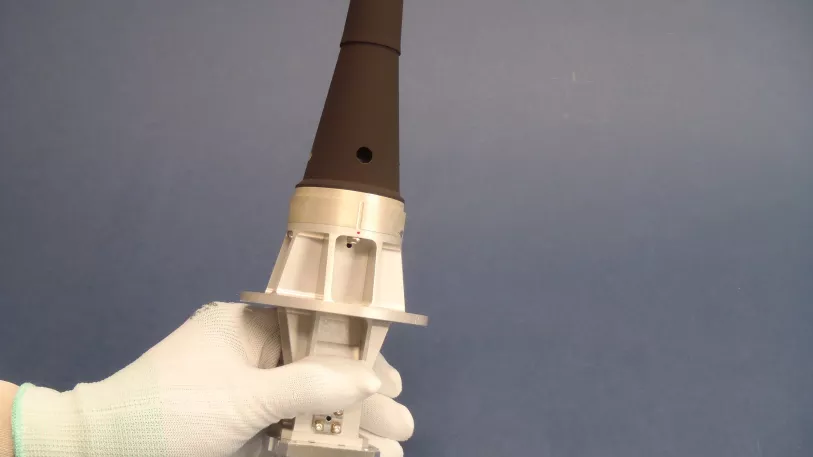
28.04.2025
Beyond Gravity: New high-power antenna for Europe’s forest satellite
On Tuesday April 29, the European forest satellite “Biomass” will be launched into space from Kourou aboard a European Vega-C rocket operated by Arianespace. Beyond Gravity supplied several key products for this mission. The satellite uses a high-power antenna developed by the company. The satellite’s precise position in orbit will be determined by a Beyond Gravity navigation receiver, and the satellite will be protected by the company’s thermal insulation.
Around 30% of Earth’s land surface is covered by forest. By absorbing carbon dioxide from the atmosphere, forests play a crucial role in the carbon cycle and climate system. The European Space Agency’s (ESA) “Biomass” forest satellite mission will observe the state and development of forests. The satellite is scheduled for launch on Tuesday, April 29, from Europe’s spaceport in Kourou, South America, aboard a European Vega-C rocket. “Forests are the green lungs of our planet, providing us with oxygen and storing carbon dioxide. With the environmental satellite Biomass, we are learning more about the importance of forests to our climate system. Contributing to the functioning of such a groundbreaking climate satellite with key products, like various antennas, our navigation receiver and our multi-layer thermal insulation is a great honor and extremely inspiring for all our colleagues,” says Oliver Grassmann, Executive Vice President Satellites at Beyond Gravity. Headquartered in Zurich (Switzerland) Beyond Gravity is a leading supplier to both established customers and New Space customers. The main contractor for Biomass is Airbus Defence and Space (UK).
New high-power antenna for Biomass
The forest satellite uses a high-power antenna from Beyond Gravity that serves the data downlink needs of new Earth-observing satellites as they gather ever larger quantities of environmental data. The antenna has the size and shape of a large ice cream cone. While more and more Earth observation data from satellites is gathered, the satellite itself becomes smaller. Thus, there was a clear need for a smaller, more powerful data downlink antenna. The X-band helix antenna design was developed for ESA by Beyond Gravity’s site in Gothenburg (Sweden). Beyond Gravity also provided the S-Band TTC (Telemetry, Tracking and Command) antenna. The TTC antenna acts as a communication and control antenna for the satellite.
Thermal protection
A thermal insulation from Beyond Gravity protects the forest satellite from the extreme cold and heat in space. A multi-layer thermal insulation made out of several layers of ultra-thin special polyimide foils will keep the instruments of the satellite at the required operating temperature despite the extremely harsh thermal environment in space. The thermal insulation was designed and produced at Beyond Gravity’s sites in Austria. Nearly every European ESA satellite is protected by thermal insulation from Beyond Gravity. Beyond Gravity also produced the Eddy Current Damper, which is part of the spacecraft's solar array wing and is providing the damping to slow down the deployment and prevent shocks at deployment completion.
Precise in-orbit position determination
The satellite’s position in space is determined to within centimeters using technology from Beyond Gravity’s site in Vienna, Austria. The more accurate the positioning, the more accurate the data provided by the satellite. The receiver can process both US GPS and European Galileo signals. Currently, Beyond Gravity’s navigation receivers determine the position of approximately 25 satellites in space. The Beyond Gravity site in Tampere, Finland, produced the Reflector Deployment Interface Unit.
Fairing, adapter and computer for Vega-C rocket
At the Beyond Gravity site in Gothenburg, Sweden, the company produced the Vega-C On Board Computer. The computer performs pre-programmed flight sequences, during launch and is part of the Vega Avionics System. The company’s site in Linköping, Sweden, delivered the payload adapter system, including the separation system, which will separate the satellite from the launch vehicle. At its location in Emmen, Switzerland, the company produced the payload fairing of the Vega-C rocket. The fairing is the top of the rocket and protects the Biomass satellite during launch and ascent into space.
About Biomass
ESA’s Biomass mission will measure forest biomass and will lead to a better understanding of the state of Earth’s forests, how they are changing over time, and advance our knowledge of the carbon cycle. Knowing the amount of carbon bound up in forest biomass will sharpen our understanding of climate change and its likely effects on the global carbon cycle. The satellite will orbit Earth at an altitude of 666 kilometers. The mission’s expected lifetime is at least 5.5 years.
How does deforestation impact our climate
Forests are home to around 80% of biodiversity on land and tropical forests alone produce over 40% of the oxygen we breathe. Climate change, forest degradation and deforestation are causing much of the carbon stored in forests to be released back into the atmosphere. By monitoring changes in biomass over time, scientists will be able to assess the effectiveness of forest conservation efforts and better understand the impact of deforestation on our climate.
How to measure forest biomass from space?
Measuring the mass of a tree from space is not easy. Unless a tree is felled and then weighed, its mass can only be inferred indirectly from structural parameters, e.g. by measuring the diameter of the trunk and then calculating the mass. The Biomass satellite mission follows a very similar approach. The radar signal emitted by the satellite will penetrate the forest canopy and the signal will be scattered back by the main structural elements of the forest (trunks, boughs etc.). The measured signal carries information about the forest structure and can be used to infer parameters such as forest biomass and forest height. Forest biomass not only includes the tree trunk, but also the bark, branches and leaves. The Biomass satellite uses a specific type of radar instrument, which not only ‘sees’ through cloud cover, but penetrates the canopy layer which allows the actual biomass of trees to be estimated.
Vega-C rocket: 35 meter tall launch vehicle
Europe’s Vega-C rocket can launch small scientific and Earth observation satellites into space. The Vega-C is 35 meters tall and weighs 210 tons on the launch pad. Vega-C is the evolution of the Vega family of rockets and delivers increased performance, greater payload volume and improved competitiveness.
ESA mission page about Biomass
Facts and figures about the Biomass mission
More information about the European Union’s Copernicus Earth observation program
More information about the Vega-C European launcher
Images
Image 1: ESA’s Biomass satellite will deliver completely new information on forest height and forest biomass from space. © ESA/ATG Medialab. Download:
Image 2: The Vega-C rocket uses a computer, payload fairing and payload adapter from Beyond Gravity. © ESA–ATG Medialab. Download:
Image 3: A new antenna from Beyond Gravity for data downlink will serve Biomass. It was developed through an ESA General Support Technology program contract with Beyond Gravity in Sweden. © ESA, Beyond Gravity. Download:
Videos
Video from ESA about how Biomass will measure forest biomass.
Please contact us for further information:
Philipp Bircher, VP Communication & Branding
philipp.bircher@beyondgravity.com
Christian Thalmayr, Senior Manager Global Communication
+43 180199, christian.thalmayr@beyondgravity.com



